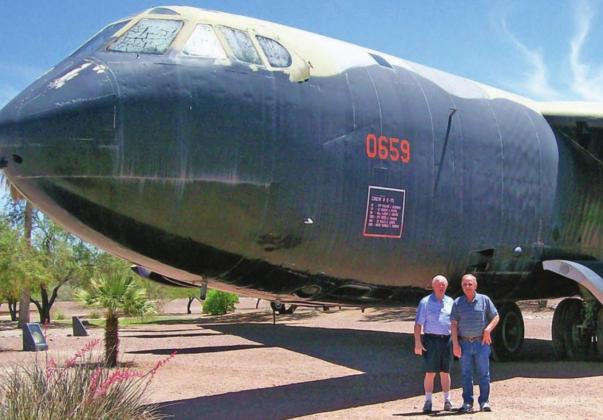Hollis Dean Jones has flown B-52 bombers with live nuclear weapons over North America, completed over 100 combat missions with iron bombs in Southeast Asia, and worked in cities around the US. Now that he’s finally retired, he’s enjoying a quiet life back in Erath County.
Jones started school at Alexander, then transferred to Dublin when he was in elementary school. He stayed there through high school, but his senior year his parents moved to Waco. Jones wanted to stay in Dublin to finish out the football season under the coach at the time, Jimmy Keeling, so he ended up living with his aunt and uncle until the end of the first semester, and then moved to Waco to join his parents.
Jones graduated with his diploma in the spring of 1961 from Waco High and went on to the University of Houston for a year before transferring to Tarleton. After a year there, he decided it just didn’t feel like the right time for school.
The next year, he joined the last class of Aviation Cadets in the Air Force who were not required to have a college degree, and embarked on several years of training. First there was navigator training, then bombardier school, then survival and combat crew training.
When he finally finished the requisite schooling and went operational, he was first stationed at Bergstrom Air Force Base in Austin. There, he joined the 486th Bomb Squadron as a Radar Navigator flying B-52s (also known as the Stratofortress).
“That was back in ‘66, and our bomb squadron was one of several nuclear mission oriented squadrons stationed in various locations around the country,” he said. “A few months after my arrival, our squadron was designated for iron bomb training.” Following that training, the squadron was moved to March Air Force Base in Riverside, California.
Six months later the squadron made their first extended visit to Southeast Asia. Jones and his crew flew over 100 combat missions together over the next couple of years out of Guam and Utapao, Thailand. “I was with the same people — same pilot, copilot, navigator, electronic warfares operator, and gunner — for three years,” Jones said. “Crew integrity was an absolute necessity on bombers, especially during airborne refueling and bomb runs. When rapid-fire mission activities began, sometimes there was no time to talk. You almost had to know what the other person was thinking.”
The team did have some close calls over the years — once they blew a tire on takeoff, with a 57,000- pound load of bombs on board. “That airplane couldn’t have taken off if we hadn’t been going over a 500-foot cliff at the northeast end of the runway in Guam,” he said. “The plane started falling rapidly and the pilot did an unbelievable job keeping it out of the Pacific. That was of particular interest to me since the radar nav. and navigator stations are in downward ejection seats which require at least 400 ft. clearance for parachute opening.”
As regular missions were concerned, SAMS (surface to air missiles) were the most attention-getting. “The North Vietnamese had several missile sites around the DMZ,” he said. “We had welcome fighter cover for missions that took us up the Ho Chi Minh Trail.”
Jones had initially planned on making a career out of his time in the Air Force, but after nearly six years and attaining the rank of Captain, he decided to return to school. He ended up going to The University of Texas at Austin on the GI Bill studying business.
While he was in school, he stayed in the reserves for a couple of years to make some extra money; then when he graduated with a bachelors and masters in business, he moved to Houston to work in financial management for several energy companies. He stayed there during the 70s and 80s. The companies he worked for included Occidental Petroleum, Howell Corp., and a Brown & Root subsidiary.
In the early 90s, Jones had a job lined up with Norton (now Saint Gobain), but when the Gulf War broke out, they decided not to expand at that time which changed his plans. He ended up moving back home to the Erath County area anyway and going to work at Tarleton. He held various administrative positions while at Tarleton but the last several were spent as the Environmental Health and Safety Officer for the university.
The job was somewhat different from previous experiences but Jones enjoyed it. “The importance of the environmental health and safety function increased tremendously during that period of time,” he said.
Jones retired from his job at Tarleton in 2007, and now spends his time reading, playing golf, and keeping up with current events.
Throughout his life, Jones has drawn inspiration from his parents, Reverend B. F. Jones and Leona Jones. “My dad was a Methodist preacher, and I was pretty fortunate to have grown up in a close-knit, religious family,” he said.
Jones’ advice to Dublin graduates is to appreciate their time in Dublin. “I left this part of the country, I’ve lived in a lot of places and I’ve been to a lot of parts of the world,” he said. “And you can do a lot worse than Erath County, Texas.”
Editor’s Note: This column chronicles what Dublin graduates have done since high school. If you have any suggestions for other graduates, email publisher@dublincitizen.com.

